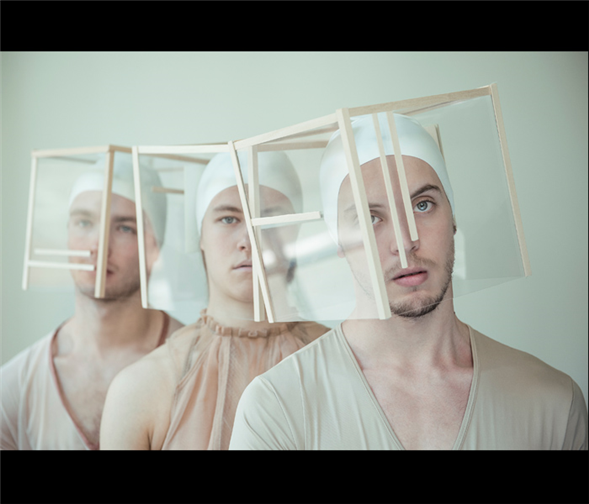Translate Page

Their new dance can't be finished without you
---
In 2014, three recent Juilliard alums looked at the resource- and time-scare dance world and decided to combine forces. They already shared an aesthetic interest in the human body and artistic principles about promoting audience engagement, so really, the chance to co-manage company responsibilities was just the next bit of synergy.
Two years later, the young, sparky trio of Jason Collins, James Lindsay Harwell, and Ingrid Kapteyn have developed a unique, effective way to satisfy their creative and practical goals at the same time.
HEWMAN, their artistic collective, focuses on creating dances… well… anywhere. The troupe is especially interested in venues that allow audiences to get close and involved with performers. "If you're in a theatre 40 feet away from the dancers, you don't see details and the effort involved," says Collins. "We want to emphasize those exact shakes and twitches to help audiences relate and see how performers' bodies are like yours. For us, immersive, installation work is the truest way to find out how to encourage audiences to dive into what's happening in the performance. Different spaces and collaboration help us widen that relate-ability."
To test their theory, HEWMAN has produced pieces all over. Garage? Check. Midtown tenement? Check. Soho loft? Check. On August 5 and 6 they take over LightSpace Studio – a 5,000 square-foot, raw space – to present This Is Nothing Without You. There, dancers and watchers have plenty of room to co-mingle, whether in open areas that are perfect for expansive, winding phrases, or in the nooks and crannies that invite even closer encounters.
For Collins, the appeal of unusual, unpredictable and flexible spaces mirrors the founders' own experiences as dancers with some of downtown dance's biggest names (Pam Tanowitz, Andrea Miller and Brian Brooks, etc.) "As freelance performers, scheduling is challenging, and we rehearse in 10 to 12 studios around town at any given time," he says. "It's built into our process to be malleable."
That's partly why HEWMAN's works are dubbed "installation pieces." As Collins explains, "We build work for any, and every, type of space. Each performance molds to the place. For our first piece, we showed it in a different location every night, and when we remounted it, we did it in two new spots. Most of the choreography is set, but there are pockets available to change and transition, plus the variable of audience interaction, which can shift at any time. You might be walking around the area where the dancers are, or you might be interacting. All of those aspects of possibility…that's the excitement."
The creative process for This Is Nothing Without You evokes what Collins calls "the messy, thrilling arena of 'try something new every time.'" Previously the choreographers either created together or by electing one leader, but this round, they crafted movement separately. "While we had check-ins over the yearlong process, this experiment gave us the freedom to get out, individually, what was in our brains," Collins says. "In April, we shared everything. We brought in puzzle pieces, and it started to become a whole when we came together."
Now, the audiences will watch a trio of resulting duets – partially fluid and gestural, sometimes angular and twitchy.
Despite the differences in individual shapes and dynamics, though, the dances do have points of thematic unity: First, they're all based loosely on human interaction, decided by the founders as the starting point for the whole project. And to some degree, they all use conversations Kapteyn recorded during rehearsals. "That exemplifies what inspires us," Collins says. "We take those everyday moments, movements, and situations and abstract them, mess with them, and create another meaning."
To add another layer of unpredictability, HEWMAN commissioned Andrew Funcheon for a percussion composition; the dancers won't hear the piece in its entirety until the performances. The troupe also recruited fellow Juilliard alumni, theatre director Jordan Geiger, to offer fresh eyes from a different artistic world. "Jordan added dramatic intention and a narrative," says Collins. "When we combine everything, it inspires us to think, 'Oh, I didn't know that was possible!'"
Finally, as the title of the work suggests, the audience contributes something to the piece as well. "Our goal is to be inclusive as possible," Collins says. "First we build trust, helping them feel welcome: You're not wearing a mask or gliding through disconnected. We're performing because of you, and we're here together. By the end of the piece, perhaps you've engaged in some way."
That engagement is central to HEWMAN's purpose. "That's what we're waiting for," Collins says. "The final key aspect is the audience's eye. They'll see Jordan's perspective layered on our perspectives of movement [which is] on top of our perspectives of relationships. It's not enough to be there. We want you to see and be seen, too. How? Well, that's up to you."
---